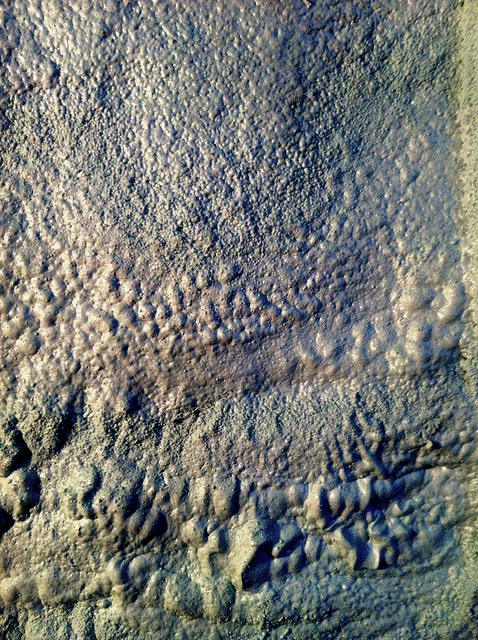IndoorDoctor provides informed and experienced consultation and testing services, particularly regarding spray foam insulation and the problems it creates. With decades of experience in home upkeep best practices, IndoorDoctor is your partner for ensuring a safer and more effective home insulation solution. Spray foam has increased in popularity due to several benefits, such as effectiveness and reduced energy costs. However, improper installation or exposure to spray foam dust can be catastrophic for your health or wallet.
Once spray foam insulation is installed, it creates a tight seal within the home. On paper, this is an excellent insulation solution. However, it does too well of a job and limits airflow throughout the house, which creates a host of issues ranging greatly in severity.
An airtight home can cause a build-up of carbon dioxide gas and trap volatile organic compounds (VOCs) or other pollutants. At the same time, the spray foam installation itself releases incredible amounts of toxic VOCs. This airtight environment also increases humidity levels, which, unchecked, can lead to mold problems within the home. This comprehensive guide is meant to be a tool for homeowners considering spray foam as an insulation solution and help them weigh the risks associated with spray foam insulation.
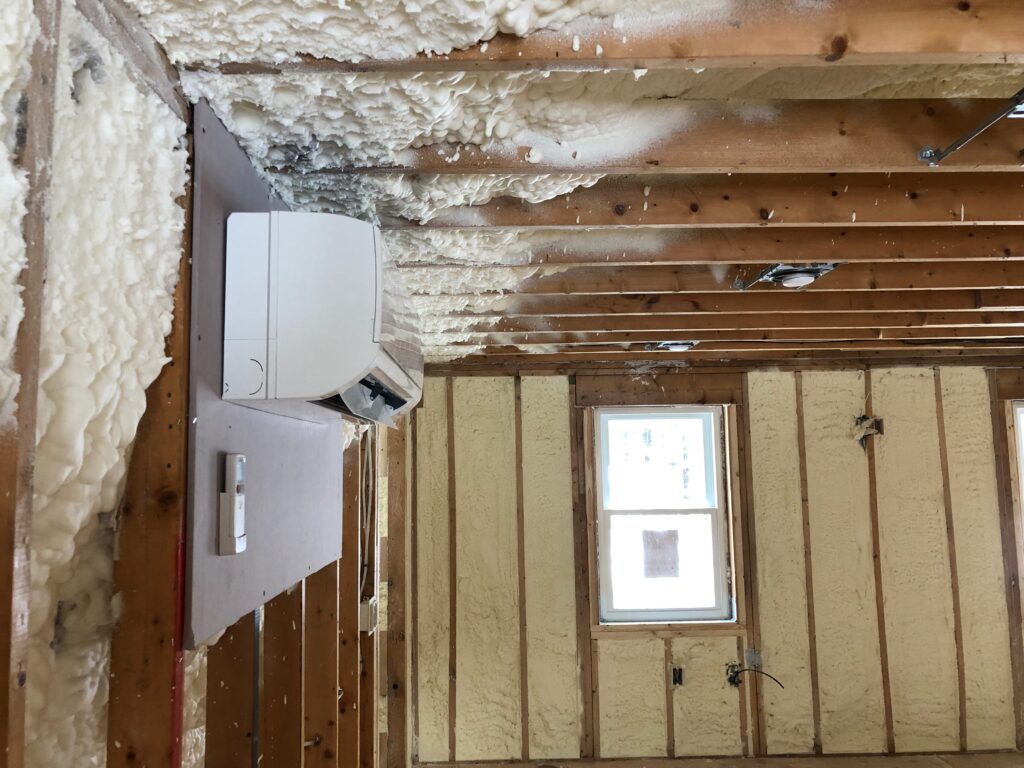
Spray Foam Insulation Overview
Spray foam insulation is a mix of compounds that, when activated, expand and harden with air pockets, creating highly insulative properties. Additionally, the surface of spray foam is water resistant, giving it incredible durability. Most spray foams are a blend of polyol resin and isocyanate. As it expands, the foam fills gaps or is used to insulate homes entirely.
Types of Spray Foam Insulation
There are two primary types of spray foam insulation: open-cell and closed-cell.
Open-cell spray foam insulation is relatively soft and flexible because the air pockets created by the compound reaction are not fully closed. It has a lower density and features strong sound-dampening capabilities. This is often the type of foam applied to any interior walls. It’s less effective at blocking the flow of heat from one location to another.
Closed-cell spray foam is denser and more compact than open-cell varieties. Every air pocket is closed, giving it a higher R-value per inch of foam. Because of its adhesive, water-resistant, and ultra-high insulative properties, closed-cell foams are commonly used in attics and basements.
Why Many Are Opting for Spray Foam
Both types of spray foam are used in residential and commercial buildings alike. Many turn to spray foam insulation for the perceived ease of application and the highly insulative properties. When installed safely and correctly, spray foam offers several benefits to consider:
Energy-efficient: Spray foam’s airtight seal makes it one of the best insulations on paper. Because of this, homes with spray foam insulation have reduced heating costs in the winter and cooling costs in the summer.
Moisture Resistant: Spray foam itself is resistant to moisture. It prevents moisture and humidity from entering a building. That said, it also prevents excess interior moisture from escaping the building, creating a higher risk of issues.
Durable Insulation: After the curing process is complete, spray foam insulation is nearly impossible to remove. It will not settle once cured, keeping the same insulative property for as long as it is installed.
Easy to Apply: Spray-on application of spray foam insulation makes it easier to install than traditional batts of insulation. The spray expands and conforms around hard-to-reach areas.
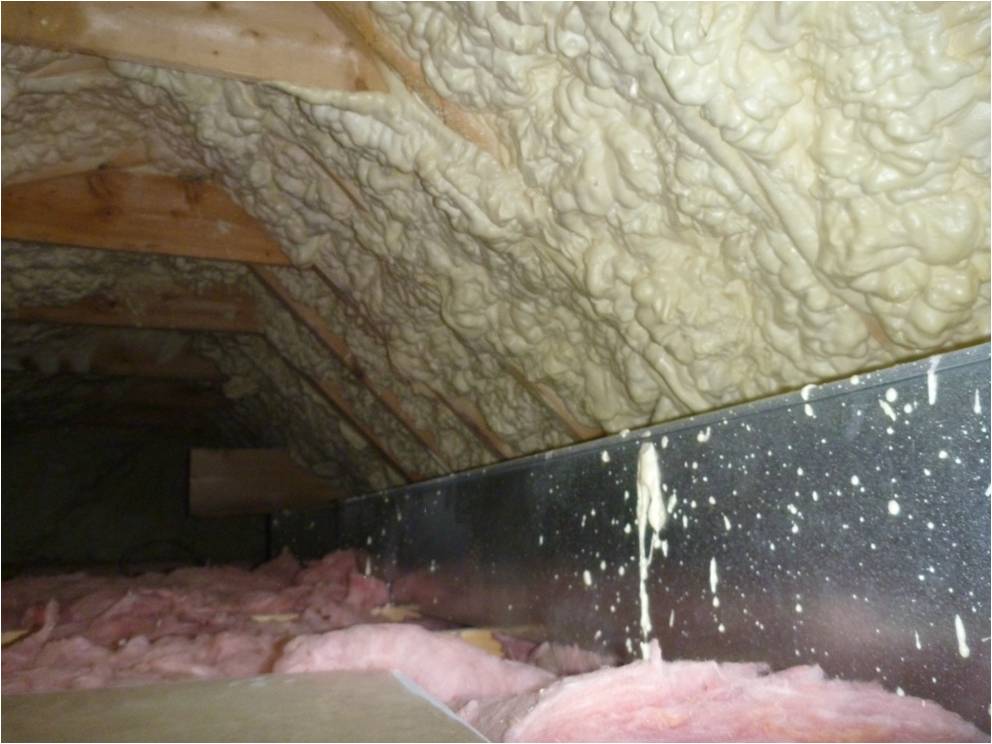
Spray Foam Insulation Installation Process
Steps must be carefully taken to properly install spray foam insulation, like ensuring an appropriate mix of polyol resin and isocyanate. Before any spray foam is actually applied, all application surfaces have to be rigorously cleaned, and any surfaces where insulation is not desired must be appropriately covered. The installation areas must be sufficiently ventilated throughout the process, and appropriate PPE (personal protective equipment) must be worn. If you choose to install spray foam in your home, it’s imperative to use a professional installer.
Common Installation Issues
The two primary compounds are sprayed through a sprayer onto the desired surface area during application. The individual spraying the compound must stay focused and apply an even amount of spray foam to all surfaces. After application, the curing process begins, and the bulk of curing is completed within the first 24 hours.
Despite seeming like a fairly simple process, several issues can arise from spray foam insulation installation. Each of them has varying degrees of severity and potential complications. If the mix of polyol and isocyanate isn’t correct, the foam will suffer from poor structural integrity or may fail to cure entirely. For spray foam to work properly, it must stick to the surfaces it’s being applied to. Spray foam may not adhere properly if applied unevenly or to dirty surfaces.
After curing, spray foam is resistant to a variety of environmental conditions. However, the compound can’t be too hot or cold during application and curing, and the environment can’t be too humid. Failure to meet the ideal conditions may result in improper curing.
Spray foam insulation, and the compounds that combine to create it are hazardous. Without proper PPE or ventilation, spray foam insulation can harm installers and future occupants. After application, spray foam insulation releases harmful VOCs. Adequate ventilation is required to off-gas these compounds from the premises.
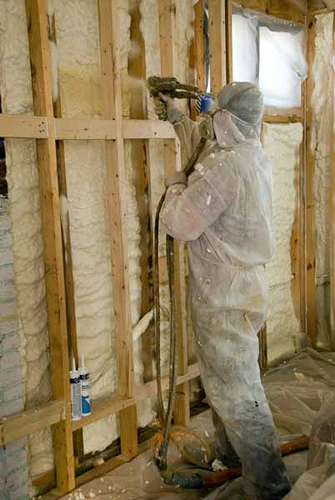
The Health Risks of Spray Foam Insulation
Spray foam presents the potential for a variety of health risks for installers and occupants during installation and afterward.
Immediate Health Risks of Spray Foam Exposure
Acute exposure to spray foam insulation (SPF) compounds includes respiratory distress and skin irritation where uncured spray foam touches. Inhaling isocyanates and other VOCs released from curing spray foam causes multiple health risks. If proper PPE isn’t worn or the building remains occupied during curing, those exposed may face throat irritation, coughing, and shortness of breath. Exposure can also cause skin and eye irritation. Additionally, headaches and nausea are associated with immediate spray foam VOC exposure.
Chronic Health Risks of Long-Term Spray Foam Exposure
Those working with spray from installations regularly are also at risk for long-term chronic conditions linked to SPF. Asthma and other respiratory issues are related to long-term exposure to the isocyanates used in spray foam applications.
Another alarming and well-documented condition related to spray foam insulation is known as sensitization. After enough exposure, affected individuals become more sensitive to other air contaminants (such as dust, pollen, etc.) and experience respiratory issues more easily, even if the new contaminant exposure isn’t related to SPF spray foam.
Understand the Chemical Hazards of Spray Foam Insulation
Many of the compounds used in SPF spray foam insulation are toxic in their own right. Uncured spray foam is a toxic soup of these compounds undergoing chemical reactions, off-gassing toxic compounds throughout the curing process.
VOCs, or volatile organic compounds, have high vapor pressure and reduced water solubility. They are found in various products, from automotive compounds to house paint and, of course, spray foam insulation. Depending on the compounds involved, they are typically responsible for headaches and nausea during acute exposure and are also potentially linked to cancer. This is why adequate ventilation is crucial when working with VOCs of any kind.
SPF spray foam may also contain other toxic compounds, such as formaldehyde, which irritates the eyes, nose, and throat and is a known carcinogen. Some spray foam manufacturers include flame retardants in the foam to provide an added layer of safety to homes and structures. However, these compounds build up over time in the body and can cause a variety of health issues, including endocrine disruption.
These are some of the most common health risks associated with SPF installation. This is why it’s crucial to ensure that the proper installation practices are taken and that the premises are well-ventilated and vacant during installation and curing.
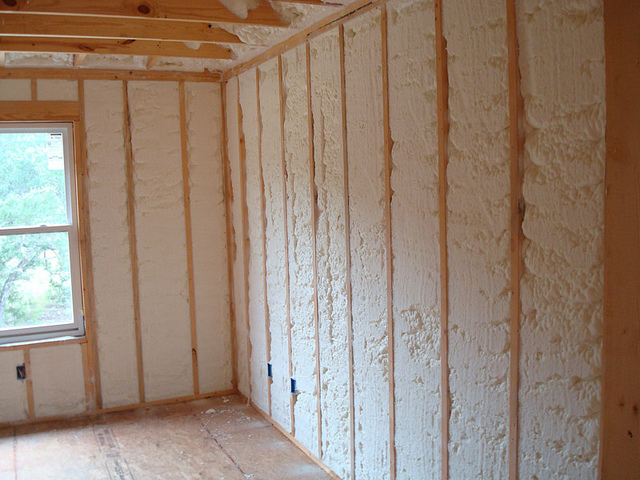
Air Quality Issues Created by Spray Foam Insulation
Outside of the health risks created by direct exposure to spray foam and associated VOCs during installation, spray foam can cause ongoing air quality issues in your home. Improper of installation of spray foam is directly associated with a decrease in indoor air quality.
Any moisture or pollutants that find their way into a home with spray foam insulation will have a harder time escaping due to the foam’s incredible sealing capabilities. This essentially traps them indoors, leading to mold development and a general decrease in air quality. Mold spore exposure and other pollutants also bring along health risks. The development of these indoor air quality issues can also remain hidden for some time, especially in less frequented attics or basements. Left unchecked, mold development can come with significant remediation expenses.
One of the risks of using SPF spray foam insulation is that it can create a near-airtight seal in buildings, greatly reducing airflow if additional steps aren’t taken to increase ventilation or airflow. Buildings without adequate airflow have less ability to prevent dangerous compounds from accumulating in a home. For example, homes with poor airflow may see a build-up of carbon dioxide, carbon monoxide, mold spores, and general airborne particulates. In a home with proper airflow, these dangerous compounds move through the air freely and eventually out of the home before they can reach dangerous levels. If this airflow is restricted too much, which can occur from improper spray foam insulation, these compounds can build up, creating a potentially dangerous situation.
Homes and buildings with spray foam insulation should consider an enhanced home ventilation system known as energy recovery ventilation or heat recovery ventilation (ERV / HRV, respectively). These can mitigate the poor airflow situations caused by spray foam insulation and provide adequate ventilation to a home once again. They also work to reduce humidity and remove pollutants from the air.
Even after an expert SPF installation, your installer may still recommend an ERV or HRV system to ensure proper ventilation and airflow in your home. Forgoing this measure puts you at greater risk of financial or health-related burdens down the road.
Challenges Associated with Spray Foam Removal or Remediation
One of the most dual-sided scenarios regarding spray foam insulation is its permanence. Once cured, spray foam is incredibly durable and resilient, ensuring it will remain effective in your home for many years without losing much, if any, efficacy. That said, if a spray foam installation fails or needs to be removed for other reasons, it’s nearly impossible to effectively remove. It can also re-create a variety of health hazards for remediation specialists and occupants alike.
What Makes Spray Foam So Hard to Remove?
Unfortunately, many of the benefits of spray foam are tied to significant downsides if the insulation has to be removed later due to improper installation or other causes. SPF spray foam insulation forms an adhesive bond to everything it touches, making removal a real challenge regardless of methods or equipment. Extra care must be taken not to damage the structure itself during removal. Spray foam can reach through and around cracks or crevices, making complete removal challenging.
This is a labor-intensive process, and labor comes with a high price tag due to the new health risks created by disturbing the hardened foam. Additionally, because of the compounds that create spray foam, special disposal measures must often be taken, further increasing the financial burden associated with removal.
How to Remove Spray Foam Insulation
Experienced spray foam removal experts have a variety of potential methods. Each has its own benefits, drawbacks, and risks.
Dry Ice Blasting: Dry ice blasting involves shooting pellets of dry ice to cut away and remove spray foam. It effectively removes large chunks of spray foam insulation. However, specialized equipment is required, and the volume of dry ice required can displace too much oxygen as the solid ice sublimates back into carbon dioxide. Additionally, the method can be too aggressive and cause damage to underlying structures.
Soda Blasting: Soda blasting uses sodium bicarbonate pellets to remove foam insulation in portions. It also has issues removing spray foam insulation from tight spaces and crevices. Because the pellets do not dissolve into a gas like dry ice does, an additional round of cleanup is needed to clean up the sodium bicarbonate.
Both removal methods require professional-grade equipment and materials. When considering the special equipment, person-hours of labor, and special disposal considerations, it’s easy to see why removing spray foam can be so costly and difficult, if it’s even possible.
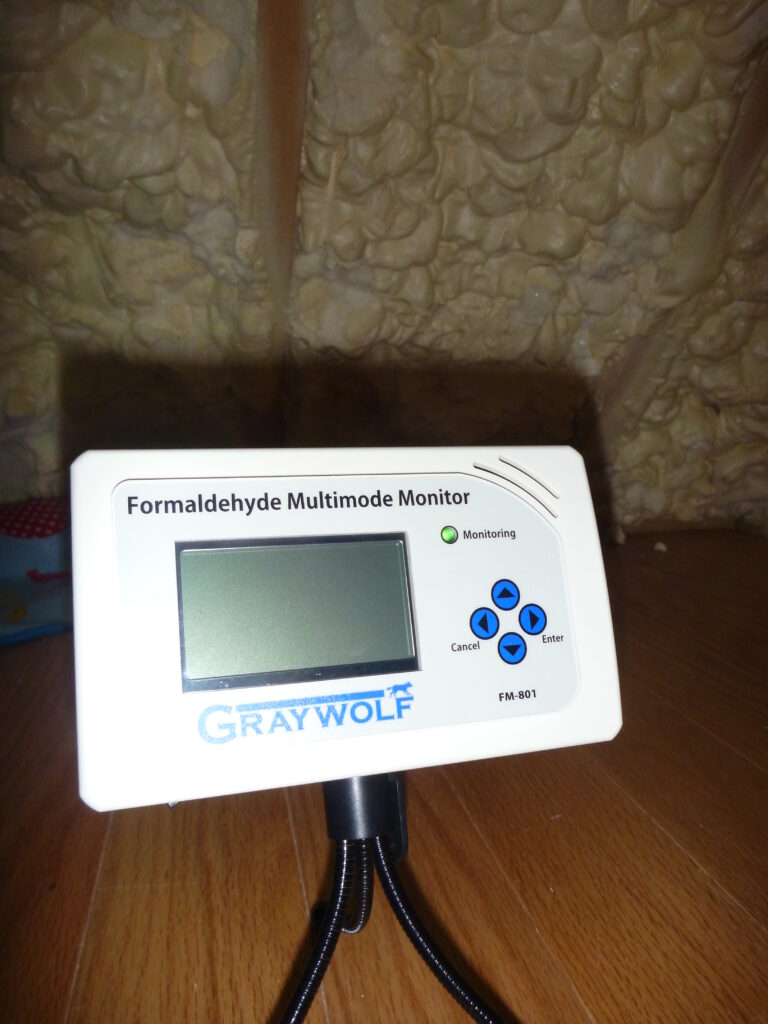
Risks of Spray Foam Insulation, the Long and Short of It
Spray foam insulation, at first glance, seems like an attractive proposal. The promise of significantly reduced energy costs and the seemingly easy “spray-on” application seems like a can’t-lose proposal. However, as you can see, the long-term and potentially short-term financial risks may not be worth the savings on your heating bill.
Short-Term Financial Risks of Spray Foam
Improper installation will set you back significantly, especially if you don’t understand the signs or symptoms of a bad installation. You may discover issues down the road that the installer suddenly fails to recognize as their fault or offer remediation. This puts you on the hook for both the removal of the bad spray foam as well as the installation of an alternative insulation method.
Long-Term Financial Risks of Spray Foam
In addition to short-term risks like the need for removal and reinstallation, spray foam can also have potential long-term complications. Property damage associated with extended moisture exposure and remediation requirements due to toxic off-gassing are the two most concerning long-term financial risks. Spray foam is incredibly resilient once cured, so you’re unlikely to see other issues, such as degradation, arise except for rare circumstances.
Moisture entrapment is when humidity becomes trapped and rises to the point of condensation. At this point, it has a high risk of working its way into the unseen building envelope, the space between the controlled environment and the outdoors. Once moisture is trapped, mold is allowed to propagate and flourish. At this point, the mold will become a serious issue before you notice any signs of its presence. When mold reaches that level, remediation is prohibitively expensive and will likely outweigh any cost savings realized from the spray foam itself.
Toxic off-gassing is the other primary long-term concern associated with spray foam insulation. Off-gassing from VOCs that become trapped in the home due to improper SPF installation creates hazards for occupants and additional costs for the installation of ventilation solutions. If this occurs in a commercial building, you may also be looking at additional costs associated with legal battles and settlements.
Before any work or installations are done on your property, residential or otherwise, be sure to contact your insurance provider to ensure your coverage includes the potential issues surrounding the work you’re doing, including spray foam.
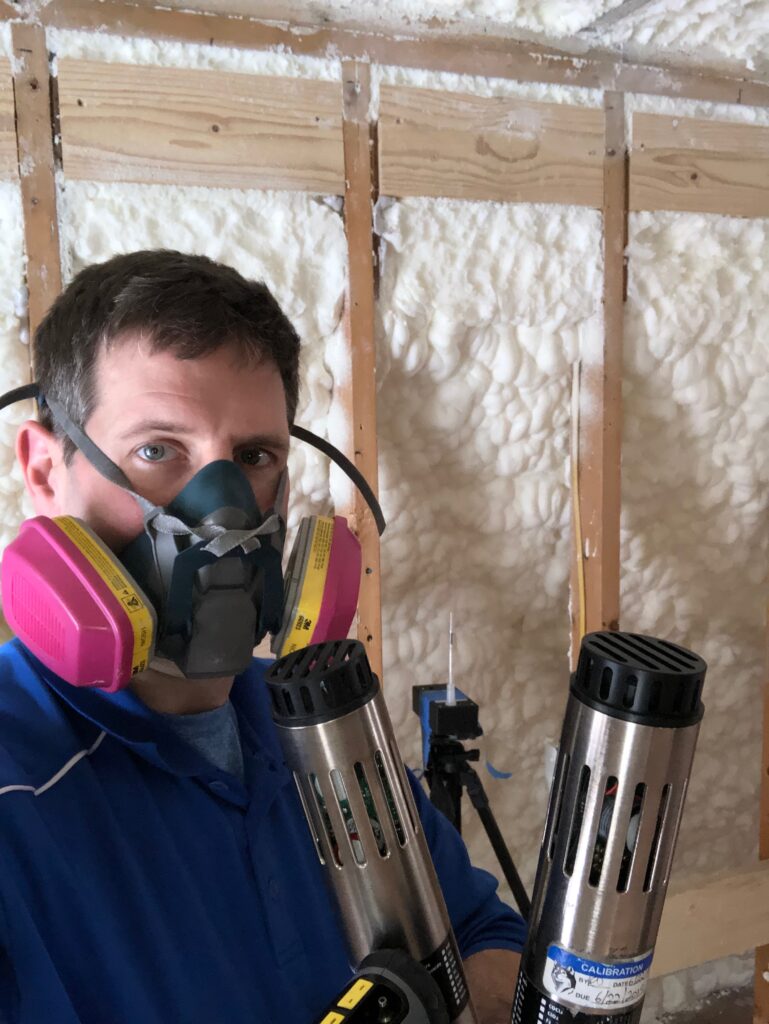
Spray Foam Insulation Alternatives
The good news is that, despite its potential benefits, there are plenty of high-quality spray foam insulation alternatives that you can consider for your new building or existing property.
Fiberglass: Fiberglass insulation was once the go-to insulation method, regardless of your situation. Because of this, it’s less expensive than other methods and is still highly effective when properly installed. This insulation is readily available and relatively easy to install, even in small spaces. Fiberglass insulation, however, can experience a loss in effectiveness if allowed to get wet, and it can cause skin irritation if exposed during installation.
Cellulose: This insulation option is made from recycled paper, making it one of the most environmentally conscious insulation types available today. That said, the insulation material is known to settle over time, reducing its effectiveness and requiring re-application. This insulation also requires additional fireproofing treatment.
Depending on your situation, home location, or other requirements, other less common insulation options may be available if you’re wary of spray foam. These include mineral wool, rigid foam board, and radiant barrier insulation.
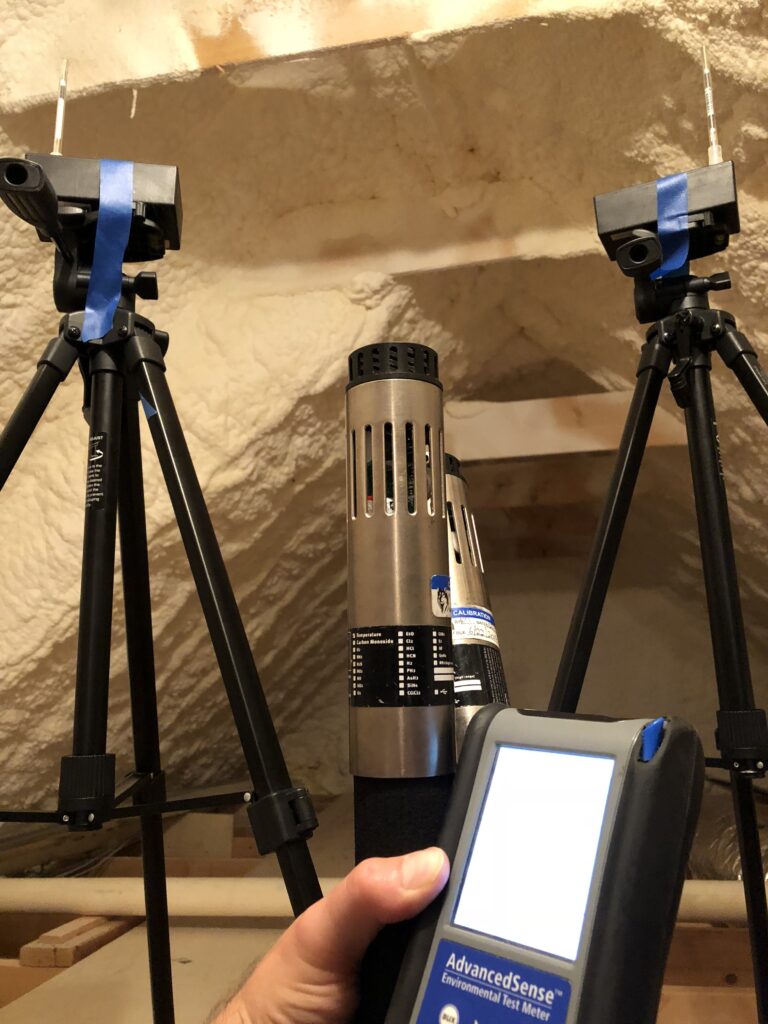
Choosing the Right Insulation for You
Here are a few factors to consider when choosing an insulation variety. The thermal performance should be high on your list when determining which solution is best for you. Those in colder climates will require higher R-value insulation, which may rule out some spray foam alternatives. Moisture control is obviously a huge concern for spray foam insulations, so you should be especially concerned about installations in humid climates. Lastly, the installation cost and risk of installation failure should also be on your mind when making a decision.
Regardless of your insulation method, allow Indoor Doctor to serve as your pre-installation and post-installation inspection service. We’ll ensure insulation is properly installed and there are no issues during or after installation. By doing so, we can also help protect you from the financial costs of failed spray foam installations.
IndoorDoctor is an expert consultation and assessment service for spray foam insulation installations. We provide in-depth testing services that look for all potential issues associated with spray foam installations. Our testing and assessments look for improper spray foam curing, toxic spray foam dust presence within the home, air quality, formaldehyde presence, mold spores, particulate matter levels, humidity, and more.
We aim to ensure your spray foam installation is completed properly and you’re safe within your home. Alternatively, if you already live in a home with a previous spray foam installation, we can look for these potentially hazardous markers and advise you on next steps if any are present.
Our comprehensive services help ensure that your new spray foam insulation is installed properly by the spray foam company you choose and make sure that your home is a safe environment for your whole family. If you have concerns about spray foam and the potential complications it causes, contact us today for a consultation and inspection.
Resources:
Potential Chemical Exposures From Spray Polyurethane Foam
VOC Emissions from Spray Polyurethane Foam
The Dangers of Using Spray Foam Insulation
Spray Polyurethane Foam Insulation: Health and Safety Recommendations for Consumers
Potential Health Hazards of SPF Chemicals
Spray Polyurethane Foam Health + Safety (What to Expect)


